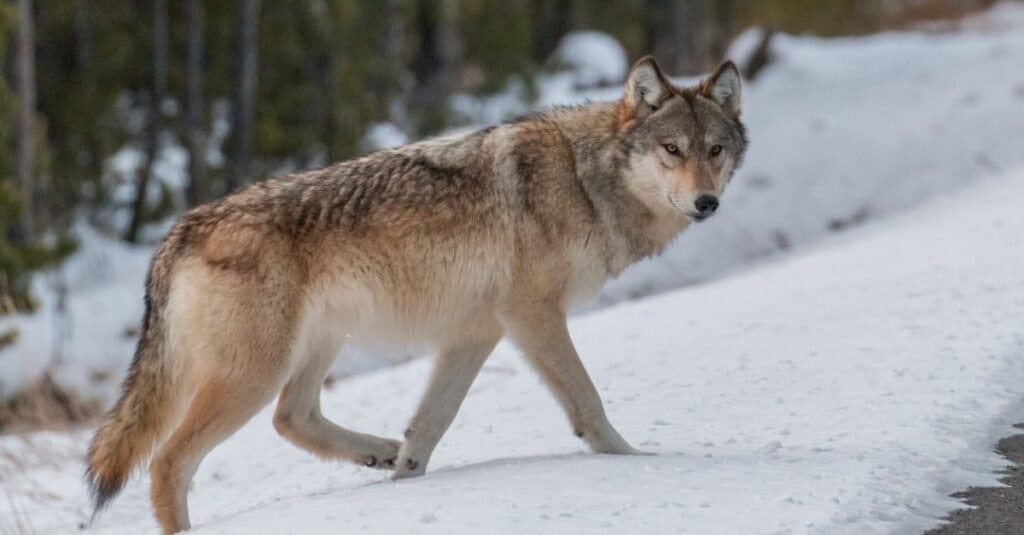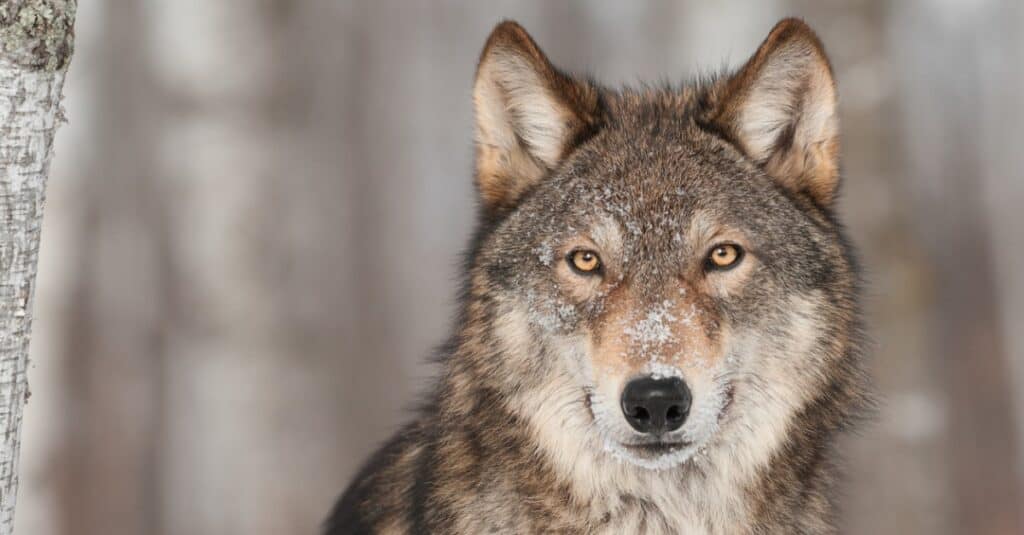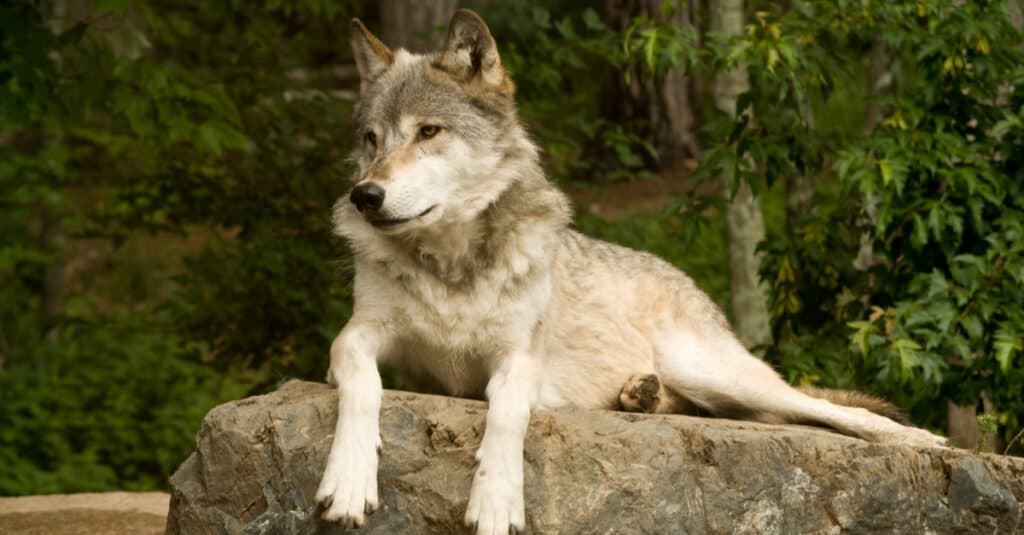In his bestselling book A Dance With Dragons, George R.R. Martin wrote, “A man might befriend a wolf, even break a wolf, but no man will ever truly tame a wolf.” Wolves have inspired countless fables, legends, and stories over their long history, and this majestic animal has inspired both adoration and fear in humankind for thousands of years.
The wolf is a member of the Canidae family along with their domestic dog cousins, jackals, and coyotes. There are two universally recognized wolf species, Canis lupus (Grey or Timber Wolf), and Canis rufus (Red Wolf). In 2020, a gold miner discovered what researchers say is the oldest and most complete specimen of the wolf species. The wolf was a puppy that lived around 57,000 years ago and was named Zhùr by the local First Nation people of Yukon, Canada!
The average lifespan of wolves in the wild is estimated to be between 6 and 8 years, however, evidence has shown that they can survive for over ten years. But how old is the oldest wolf in the world?
How Many Species of Wolves Are There?

The oldest wolf in the world reached 19 years of age.
©iStock.com/mtnmichelle
While grey wolves and red wolves are quite similar, they are two separate species, Canis Lupus and Canis Rufus.
Grey wolves and red wolves are scientifically confirmed as separate species according to DNA analysis and physical characteristics. Adult grey wolves are between 4 and 6.56 feet long (120-200 centimeters), weighing between 40 and 179 pounds (18-79 kilograms). They typically have thick grey fur with occasional all-white or all-black variations.
Adult red wolves are significantly smaller, between 4.5 and 5.5 feet (137-168 centimeters) long, weighing 50-80 pounds (23-36 kilograms). They have sleek buff or red fur that is usually black around the spine, and the back of the head, ears, and legs are occasionally tinged with red. red wolves have longer legs compared to the grey wolf, and they have taller offset ears.
Red Wolves Are Not Coyotes
The debate over the red wolf’s status is due to the species’ strong similarity to coyotes. Evidence of breeding between coyotes and red wolves suggested that the red wolf could be a hybrid species classified as a coyote rather than a wolf.
The true origins of red wolves haven’t been universally decided by the scientific community. However, DNA analysis and biological studies confirmed in April of 2019 that the red wolf is a distinct species within the Canis genus. These studies confirmed that red wolves share distinct genetic markers with the grey wolf that are not present in coyotes using DNA analysis.
How Many Kinds of Grey Wolves Are There?

In the wild wolves have a lifespan of 6 to 8 years
©Holly Kuchera/Shutterstock.com
There are five universally recognized subspecies of grey wolves in North America. In Eurasia, the possible seven to twelve subspecies are referred to collectively as Canis L. lupus, or Eurasian Wolves. Subspecies are hard to pin down, due to the vast distances wolves can travel. Territories for packs overlap, causing different subspecies to breed and blend.
Recognized subspecies of the grey wolf:
- Canis lupus lycaon (Eastern Timber Wolf)
- Canis lupus arctos (Arctic Wolf)
- Canis lupus nubilus (Great Plains/Buffalo Wolf)
- Canis lupus baileyi (Mexican Wolf/Lobo)
- Canis lupus occidentalis (Rocky Mountain/Mackenzie Valley Wolf)
The Wolf Essentials: Habitat, Environment, And Lifestyle
Wolves are experts when it comes to survival, and can thrive in forests, grasslands, snowy terrain, even the desert! Wolves are habitat generalists, meaning they are highly adaptable to changes in habitat and environment. While red wolves are only found in the south-central United States, grey wolves are found throughout North America and Eurasia.
Wolves are carnivores that compete for prey with coyotes and foxes, as well as larger animals like mountain lions and bears. Wolves can survive for weeks without eating by consuming large amounts when prey is available and storing food for their young in leaner times. Red wolves tend to hunt small mammals and insects and can eat up to 5 pounds per day. Grey wolves predominantly choose larger prey like elk and deer and can pack away up to 22.5 pounds!
The Strength of The Wolf Is the Pack
Wolves live in groups and do everything together. Packs are families that consist of a mated pair and their offspring. All pack members take care of pups, but the mated pair may be the only ones that produce them. Wolves may occasionally live independently, most will join another pack. They become hunters around 6 months old and are fully grown at 2 years.
Red wolves form small packs, with 2 to 8 members. Grey wolves form larger packs of 20-30. The Druid Pack in Yellowstone National Park once had up to 30 members!
In Memoriam: Madadh, The Oldest Recorded Wolf in The World
The oldest wolf in the world was a 19-year-old female named Madadh, nicknamed Maddie by her caretakers. Madadh and her brother Kgosi were rescued from a wildlife park at ten days old by Tony Haighway. Tony raised both Madadh and Kgosi in Wolfwatch UK, one of the most beautiful natural wolves rescues in the UK.
Madadh and Kgosi lived alongside Tony and the caretakers of Wolfwatch UK their entire lives, taking advantage of Wolfwatch’s acres of wilderness and fresh mountain water. They shared the company of fellow wolves, often howling greetings to their neighbors. Madadh and Kgosi were remarkably social and enjoyed meeting new people alongside their caretakers, but they shared a special bond with Tony.
Kgosi passed away in May of 2017 at the age of 18 years old. Madadh, the world’s oldest wolf, died shortly after in October 2017. Madadh passed peacefully in the arms of her lifelong best friend Tony. Tony later released a heartfelt tribute to her, ending with these poignant thoughts:
“Nothing else could have delivered the depth of pleasure that the sum of experiences of being around them gave to me. It’s been a privilege to have shared in their lives. Madadh was an exceptional Wolf. Whilst always her boss, she was also the most socialized example of her species that I have ever met or heard of. She loved meeting people. The mutual excitement of Wolf and Human at the point of greeting was mirrored in their faces and as I write this
The volume of messages and expressions of sadness at her passing shows the depth of feeling and the extent to which she touched so many people’s lives. I, along with so many others, will miss her greatly. Thank You for all your support, without which Wolf Watch would not exist.”
The Oldest Recorded Wild Wolf in Washington: 32M

Wolves in the wild rarely live past 12 years old.
©Carol Heesen/Shutterstock.com
The oldest known wild wolf in Washington State was known as 32M, and at 12 years old he may have been the oldest wild wolf in the world. 32M is referred to as one of the founding fathers of the 21st century Washington wolves, siring at least five litters between three mates.
He was born in the Methow Valley of north-central Washington in the late 2000s and is believed to be one of the first pups born in Washington’s Lookout pack. The Lookout pack was the first Washington wolf pack in 80 years. 32M traveled nearly 80 miles to Teanaway River Valley with his first mate to establish territory and was the patriarch of the Teanaway Pack.
32M passed away in the summer of 2020 after a long and legendary journey.
Kennai: The Oldest Wolf Ever at The NY Zoo
Kennai was the oldest wolf to live at the New York Zoo in Waterton, NY. He arrived with his mate Kaja on December 8, 2008, and the pair have littered 30 pups. One pup named Luna still lives in the NY Zoo.
Kennai was close to Madadh in age at 14 years old and was the next in line for the oldest living wolf in the world. Sadly, Kennai passed away in November of 2021 from kidney failure due to old age. He died while under the close observation of caretakers near his mate Kaja.
Larry Sorel, Executive Director of the New York Zoo, released a touching statement after Kennai’s passing:
“Kennai will be greatly missed by all, especially those guests that had the chance to hear the ‘howling ballads’ by him, Kaja, and Luna while at the zoo. His life was symbolic of our great conservation efforts, as well as the amazing work of the zookeepers here. We are proud to have had him in our care.”
Conservation: Are Wolves Endangered?
In the past, wolves could be found everywhere above the equator, with huge populations in North America and Eurasia. However, wolves were driven to the brink of extinction, largely due to being hunted like pests by farmers and cattle ranchers that saw wolves as a threat to livestock. These landowners also took over most of their territory, severely limiting their population and mobility.
This was especially true in North America, where grey wolf populations came close to disappearing entirely. In 1974, the grey wolf was placed on the Endangered Species List by the U.S. Fish and Wildlife Service.
As of October 2020, grey wolves number in the thousands and were officially removed from the Endangered Species list. However, this is a fraction of their historic population, and wolves only occupy ten percent of their prior range. Conservationists believe that while the grey wolf is thriving, it may still be endangered.
The red wolf is the most endangered wolf species in the world and was declared as threatened with extinction by the U.S. Fish and Wildlife Service in 1967. Red wolves are still being hunted and killed today, and only 15-17 red wolves exist in the wild and 241 in captive breeding facilities.
The photo featured at the top of this post is © Alexander Sviridov/Shutterstock.com
Thank you for reading! Have some feedback for us? Contact the AZ Animals editorial team.






